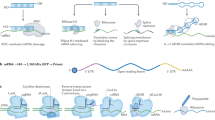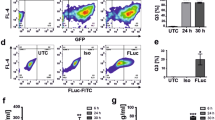Abstract
Systemic and target-specific delivery of large genetic contents has been difficult to achieve. Although viruses effortlessly deliver kilobase-long genome into cells, its clinical use has been hindered by serious safety concerns and the mismatch between native tropisms and desired targets. Nonviral vectors, in contrast, are limited by low gene transfer efficiency and inherent cytotoxicity. Here we devised virus-mimetic polyplex particles (VMPs) based on electrostatic self-assembly among polyanionic peptide (PAP), cationic polymer polyethyleneimine (PEI) and nucleic acids. We fused PAP to the engineered ligand-binding domain of integrin αLβ2 to target intercellular adhesion molecule-1 (ICAM-1), an inducible marker of inflammation. Fully assembled VMPs packaged large genetic contents, bound specifically to target molecules, elicited receptor-mediated endocytosis and escaped endosomal pathway, resembling intracellular delivery processes of viruses. Unlike conventional PEI-mediated transfection, molecular interaction-dependent gene delivery of VMPs was unaffected by the presence of serum and achieved higher efficiency without toxicity. By targeting overexpressed ICAM-1, VMPs delivered genes specifically to inflamed endothelial cells and macrophages both in vitro and in vivo. Simplicity and versatility of the platform and inflammation-specific delivery may open up opportunities for multifaceted gene therapy that can be translated into the clinic and treat a broad range of debilitating immune and inflammatory diseases.
This is a preview of subscription content, access via your institution
Access options
Subscribe to this journal
Receive 12 print issues and online access
$259.00 per year
only $21.58 per issue
Buy this article
- Purchase on Springer Link
- Instant access to full article PDF
Prices may be subject to local taxes which are calculated during checkout






Similar content being viewed by others
References
Hacein-Bey-Abina S, Hauer J, Lim A, Picard C, Wang GP, Berry CC et al. Efficacy of gene therapy for X-linked severe combined immunodeficiency. N Engl J Med 2010; 363: 355–364.
Bainbridge JW, Smith AJ, Barker SS, Robbie S, Henderson R, Balaggan K et al. Effect of gene therapy on visual function in Leber's congenital amaurosis. N Engl J Med 2008; 358: 2231–2239.
Manno CS, Pierce GF, Arruda VR, Glader B, Ragni M, Rasko JJ et al. Successful transduction of liver in hemophilia by AAV-Factor IX and limitations imposed by the host immune response. Nat Med 2006; 12: 342–347.
Mendell JR, Campbell K, Rodino-Klapac L, Sahenk Z, Shilling C, Lewis S et al. Dystrophin immunity in Duchenne's muscular dystrophy. N Engl J Med 2010; 363: 1429–1437.
Breitbach CJ, Burke J, Jonker D, Stephenson J, Haas AR, Chow LQ et al. Intravenous delivery of a multi-mechanistic cancer-targeted oncolytic poxvirus in humans. Nature 2011; 477: 99–102.
McCormack MP, Rabbitts TH . Activation of the T-cell oncogene LMO2 after gene therapy for X-linked severe combined immunodeficiency. N Engl J Med 2004; 350: 913–922.
Yang Y, Nunes FA, Berencsi K, Furth EE, Gonczol E, Wilson JM . Cellular immunity to viral antigens limits E1-deleted adenoviruses for gene therapy. Proc Natl Acad Sci USA 1994; 91: 4407–4411.
Yang Y, Li Q, Ertl HC, Wilson JM . Cellular and humoral immune responses to viral antigens create barriers to lung-directed gene therapy with recombinant adenoviruses. J Virol 1995; 69: 2004–2015.
Lv H, Zhang S, Wang B, Cui S, Yan J . Toxicity of cationic lipids and cationic polymers in gene delivery. J Control Release 2006; 114: 100–109.
Luo D, Saltzman WM . Synthetic DNA delivery systems. Nat Biotechnol 2000; 18: 33–37.
Moret I, Esteban Peris J, Guillem VM, Benet M, Revert F, Dasi F et al. Stability of PEI-DNA and DOTAP-DNA complexes: effect of alkaline pH, heparin and serum. J Control Release 2001; 76: 169–181.
Staprans I, Felts JM . Isolation and characterization of glycosaminoglycans in human plasma. J Clin Invest 1985; 76: 1984–1991.
Ruponen M, Yla-Herttuala S, Urtti A . Interactions of polymeric and liposomal gene delivery systems with extracellular glycosaminoglycans: physicochemical and transfection studies. Biochim Biophys Acta 1999; 1415: 331–341.
Kumar P, Ban HS, Kim SS, Wu H, Pearson T, Greiner DL et al. T cell-specific siRNA delivery suppresses HIV-1 infection in humanized mice. Cell 2008; 134: 577–586.
Peer D, Park EJ, Morishita Y, Carman CV, Shimaoka M . Systemic leukocyte-directed siRNA delivery revealing cyclin D1 as an anti-inflammatory target. Science 2008; 319: 627–630.
Song E, Zhu P, Lee SK, Chowdhury D, Kussman S, Dykxhoorn DM et al. Antibody mediated in vivo delivery of small interfering RNAs via cell-surface receptors. Nat Biotechnol 2005; 23: 709–717.
Davis ME, Zuckerman JE, Choi CH, Seligson D, Tolcher A, Alabi CA et al. Evidence of RNAi in humans from systemically administered siRNA via targeted nanoparticles. Nature 2010; 464: 1067–1070.
Waehler R, Russell SJ, Curiel DT . Engineering targeted viral vectors for gene therapy. Nat Rev Genet 2007; 8: 573–587.
Maheshri N, Koerber JT, Kaspar BK, Schaffer DV . Directed evolution of adeno-associated virus yields enhanced gene delivery vectors. Nat Biotechnol 2006; 24: 198–204.
Douglas JT, Rogers BE, Rosenfeld ME, Michael SI, Feng M, Curiel DT . Targeted gene delivery by tropism-modified adenoviral vectors. Nat Biotechnol 1996; 14: 1574–1578.
Lee RJ, Huang L . Folate-targeted, anionic liposome-entrapped polylysine-condensed DNA for tumor cell-specific gene transfer. J Biol Chem 1996; 271: 8481–8487.
Erbacher P, Remy JS, Behr JP . Gene transfer with synthetic virus-like particles via the integrin-mediated endocytosis pathway. Gene Therapy 1999; 6: 138–145.
Ogris M, Brunner S, Schuller S, Kircheis R, Wagner E . PEGylated DNA/transferrin-PEI complexes: reduced interaction with blood components, extended circulation in blood and potential for systemic gene delivery. Gene Therapy 1999; 6: 595–605.
Wagner E, Zenke M, Cotten M, Beug H, Birnstiel ML . Transferrin-polycation conjugates as carriers for DNA uptake into cells. Proc Natl Acad Sci USA 1990; 87: 3410–3414.
Boussif O, Lezoualc'h F, Zanta MA, Mergny MD, Scherman D, Demeneix B et al. A versatile vector for gene and oligonucleotide transfer into cells in culture and in vivo: polyethylenimine. Proc Natl Acad Sci USA 1995; 92: 7297–7301.
Sadeqzadeh E, Rahbarizadeh F, Ahmadvand D, Rasaee MJ, Parhamifar L, Moghimi SM . Combined MUC1-specific nanobody-tagged PEG-polyethylenimine polyplex targeting and transcriptional targeting of tBid transgene for directed killing of MUC1 over-expressing tumour cells. J Control Release 2011; 156: 85–91.
Somiya M, Yoshimoto N, Iijima M, Niimi T, Dewa T, Jung J et al. Targeting of polyplex to human hepatic cells by bio-nanocapsules, hepatitis B virus surface antigen L protein particles. Bioorg Med Chem 2012; 20: 3873–3879.
Hildebrandt IJ, Iyer M, Wagner E, Gambhir SS . Optical imaging of transferrin targeted PEI/DNA complexes in living subjects. Gene Therapy 2003; 10: 758–764.
Kunath K, von Harpe A, Fischer D, Kissel T . Galactose-PEI-DNA complexes for targeted gene delivery: degree of substitution affects complex size and transfection efficiency. J Control Release 2003; 88: 159–172.
Godbey WT, Wu KK, Mikos AG . Poly(ethylenimine) and its role in gene delivery. J Control Release 1999; 60: 149–160.
Sonawane ND, Szoka FC Jr, Verkman AS . Chloride accumulation and swelling in endosomes enhances DNA transfer by polyamine-DNA polyplexes. J Biol Chem 2003; 278: 44826–44831.
Akinc A, Thomas M, Klibanov AM, Langer R . Exploring polyethylenimine-mediated DNA transfection and the proton sponge hypothesis. J Gene Med 2005; 7: 657–663.
Dustin ML, Rothlein R, Bhan AK, Dinarello CA, Springer TA . Induction by IL 1 and interferon-gamma: tissue distribution, biochemistry, and function of a natural adherence molecule (ICAM-1). J Immunol 1986; 137: 245–254.
Marlin SD, Springer TA . Purified intercellular adhesion molecule-1 (ICAM-1) is a ligand for lymphocyte function-associated antigen 1 (LFA-1). Cell 1987; 51: 813–819.
Albelda SM, Smith CW, Ward PA . Adhesion molecules and inflammatory injury. FASEB J 1994; 8: 504–512.
van de Stolpe A, van der Saag PT . Intercellular adhesion molecule-1. J Mol Med (Berl) 1996; 74: 13–33.
Tomassini JE, Graham D, DeWitt CM, Lineberger DW, Rodkey JA, Colonno RJ . cDNA cloning reveals that the major group rhinovirus receptor on HeLa cells is intercellular adhesion molecule 1. Proc Natl Acad Sci USA 1989; 86: 4907–4911.
Grunert HP, Wolf KU, Langner KD, Sawitzky D, Habermehl KO, Zeichhardt H . Internalization of human rhinovirus 14 into HeLa and ICAM-1-transfected BHK cells. Med Microbiol Immunol 1997; 186: 1–9.
Muro S, Wiewrodt R, Thomas A, Koniaris L, Albelda SM, Muzykantov VR et al. A novel endocytic pathway induced by clustering endothelial ICAM-1 or PECAM-1. J Cell Sci 2003; 116 (Pt 8): 1599–1609.
Jin M, Song G, Carman CV, Kim YS, Astrof NS, Shimaoka M et al. Directed evolution to probe protein allostery and integrin I domains of 200,000-fold higher affinity. Proc Natl Acad Sci USA 2006; 103: 5758–5763.
Park S, Kang S, Veach AJ, Vedvyas Y, Zarnegar R, Kim JY et al. Self-assembled nanoplatform for targeted delivery of chemotherapy agents via affinity-regulated molecular interactions. Biomaterials 2010; 31: 7766–7775.
Kang S, Park T, Chen X, Dickens G, Lee B, Lu K et al. Tunable physiologic interactions of adhesion molecules for inflamed cell-selective drug delivery. Biomaterials 2011; 32: 3487–3498.
Chen X, Wong R, Khalidov I, Wang AY, Leelawattanachai J, Wang Y et al. Inflamed leukocyte-mimetic nanoparticles for molecular imaging of inflammation. Biomaterials 2011; 32: 7651–7661.
Huth JR, Olejniczak ET, Mendoza R, Liang H, Harris EA, Lupher ML Jr. et al. NMR and mutagenesis evidence for an I domain allosteric site that regulates lymphocyte function-associated antigen 1 ligand binding. Proc Natl Acad Sci USA 2000; 97: 5231–5236.
Choe S, Bennett MJ, Fujii G, Curmi PM, Kantardjieff KA, Collier RJ et al. The crystal structure of diphtheria toxin. Nature 1992; 357: 216–222.
Coussens LM, Werb Z . Inflammation and cancer. Nature 2002; 420: 860–867.
Ross R . Atherosclerosis—an inflammatory disease. N Engl J Med 1999; 340: 115–126.
Chow JC, Young DW, Golenbock DT, Christ WJ, Gusovsky F . Toll-like receptor-4 mediates lipopolysaccharide-induced signal transduction. J Biol Chem 1999; 274: 10689–10692.
Subauste MC, Jacoby DB, Richards SM, Proud D . Infection of a human respiratory epithelial cell line with rhinovirus. Induction of cytokine release and modulation of susceptibility to infection by cytokine exposure. J Clin Invest 1995; 96: 549–557.
Folkman J . Angiogenesis in cancer, vascular, rheumatoid and other disease. Nat Med 1995; 1: 27–31.
Cabantous S, Terwilliger TC, Waldo GS . Protein tagging and detection with engineered self-assembling fragments of green fluorescent protein. Nat Biotechnol 2005; 23: 102–107.
Soriano P . The PDGF alpha receptor is required for neural crest cell development and for normal patterning of the somites. Development 1997; 124: 2691–2700.
Cudre-Mauroux C, Occhiodoro T, Konig S, Salmon P, Bernheim L, Trono D . Lentivector-mediated transfer of Bmi-1 and telomerase in muscle satellite cells yields a duchenne myoblast cell line with long-term genotypic and phenotypic stability. Hum Gene Ther 2003; 14: 1525–1533.
Zou K, Yuan Z, Yang Z, Luo H, Sun K, Zhou L et al. Production of offspring from a germline stem cell line derived from neonatal ovaries. Nat Cell Biol 2009; 11: 631–636.
Acknowledgements
This work was supported by a Scientist Development Grant (to MMJ) and a Predoctoral Fellowship (to SK) offered by the American Heart Association. We thank the assistance of Carol J. Bayles and the Microscopy and Imaging Facility of the Cornell Biotechnology Research Center. We also thank the assistance of Christine M. Peterson and other veterinarians at the Cornell Center for Animal Resources and Education. We wish to thank John S. L. Parker, Matthew P. DeLisa, Adam J. Bisogni and David M. Lin for insightful discussions and technical help.
Author information
Authors and Affiliations
Corresponding author
Ethics declarations
Competing interests
The authors declare no conflict of interest.
Additional information
Supplementary Information accompanies this paper on Gene Therapy website
Supplementary information
Rights and permissions
About this article
Cite this article
Kang, S., Lu, K., Leelawattanachai, J. et al. Virus-mimetic polyplex particles for systemic and inflammation-specific targeted delivery of large genetic contents. Gene Ther 20, 1042–1052 (2013). https://doi.org/10.1038/gt.2013.29
Received:
Revised:
Accepted:
Published:
Issue Date:
DOI: https://doi.org/10.1038/gt.2013.29
Keywords
This article is cited by
-
Micromolar affinity CAR T cells to ICAM-1 achieves rapid tumor elimination while avoiding systemic toxicity
Scientific Reports (2017)
-
The activation of p38MAPK and JNK pathways in bovine herpesvirus 1 infected MDBK cells
Veterinary Research (2016)



